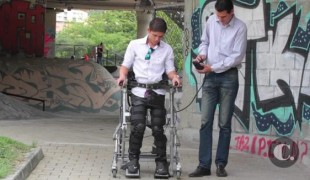- 3483
- 291
- 3
- 3
- 0
- Help Ukraine
About the solution
Phil became paraplegic after a diving accident when he just a teenager. He has limited mobility in his arms. He developed this solution because he used a ramp to get in his car for years. But one day he accidentally fell backwards three feet down and landed on his head. So he needed an alternative.
After a few years of experimenting, he came up with Drop Down Truck™. It consists of a drop-down system that allows people with limited mobility easier and safer access to the vehicle. It’s safer not only in entering but also in exiting the vehicle (it can be applied to cars, trucks, vans and buses).
Phil adapted this system to his car, which he has been driving for several years now. The technology has a gravity-based drop in case of an emergency, and less of the truck needs to be cut out since a ramp needs more square footage.
The inventor holds numerous patents that are incorporated into the design. He invested around $25,000 of his own money into the project. Phil says that his concept would expand wheelchair access beyond traditional vans to include SUV’s and pick-up trucks.
Adapted from: https://cbsloc.al/2JfC4GR
More info: http://dropdowntruck.com/
https://www.youtube.com/watch?v=Qu_a0keWeEA
This solution shall not include mention to the use of drugs, chemicals or biologicals (including food); invasive devices; offensive, commercial or inherently dangerous content. This solution was not medically validated. Proceed with caution! If you have any doubts, please consult with a health professional.
DISCLAIMER: This story was written by someone who is not the author of the solution, therefore please be advised that, although it was written with the utmost respect for the innovation and the innovator, there can be some incorrect statements. If you find any errors please contact the patient Innovation team via info@patient-innovation.com
-
-
247
-
0
-
2722

Collaborator James Leckey makes equipment to improve the quality of life and social inclusion of children with special needs
MOVING IN A WHEELCHAIR: Moving using a wheelchair.
BODY BALANCE: Maintaining body balance
STANDING UP: Standing up from a seated position
Playing
Neuromuscular Disorders
Assistive Daily Life Device (to help ADL)
Walking Aid (wheelchair/walker/crutches)
Assistive Technology access
5 Senses support devices: (glasses, hearing aids, headphones...)
Restoring mobility
Promoting self-management
Managing Neurological Disorders
Promoting inclusivity and social integration
Maintaining Balance and Mobility
Raise awareness
General and Family Medicine
Neurology
Orthopedics
Pediatrics
Physical Medicine and Rehabilitation
United States
-
-
-
519
-
0
-
7423

Scooter for disabled people
MOVING IN A WHEELCHAIR: Moving using a wheelchair.
CAREGIVING
Amyotrophic Lateral Sclerosis
Assistive Daily Life Device (to help ADL)
Walking Aid (wheelchair/walker/crutches)
Gait abnormalities (e.g., walking difficulties, unsteady gait)
Muscle cramps or spasms
Difficulty coordinating movements
Stiffness or rigidity (difficulty moving)
Paralysis of the legs and lower body
Muscle weakness
Fatigue
Restoring mobility
Promoting self-management
Rehabilitating After Stroke
Managing Neurological Disorders
Promoting inclusivity and social integration
Preventing (Vaccination, Protection, Falls, Research/Mapping)
Caregiving Support
Neurology
Orthopedics
Rheumatology
United States
-
-
-
463
-
0
-
6657

Engineer develops low cost exoskeleton inspired by a friend
WALKING: Walking
MOVING IN A WHEELCHAIR: Moving using a wheelchair.
Spinal Cord and Nerve Root Disorders
Accident
Cervical spinal cord injury/Tetraplegia
Walking Aid (wheelchair/walker/crutches)
Assistive Daily Life Device (to help ADL)
Muscle cramps or spasms
Stiffness or rigidity (difficulty moving)
Paralysis of the legs and lower body
Muscle weakness
Restoring mobility
Promoting self-management
Managing Neurological Disorders
Promoting inclusivity and social integration
Preventing (Vaccination, Protection, Falls, Research/Mapping)
Neurology
Orthopedics
Colombia
-
 en
en